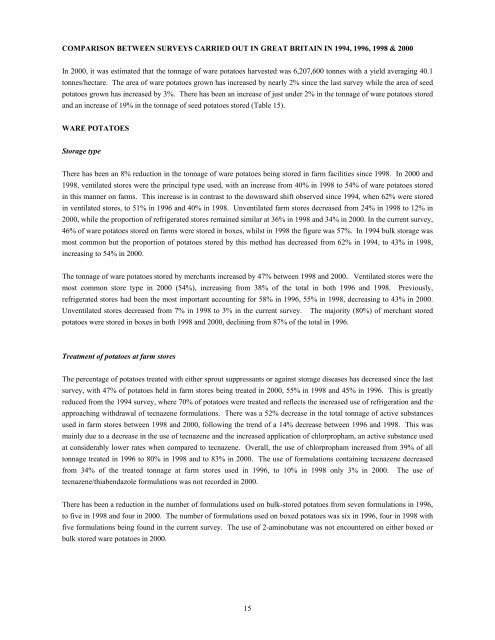Potato Stores in Great Britain - The Food and Environment Research ...
Potato Stores in Great Britain - The Food and Environment Research ...
Potato Stores in Great Britain - The Food and Environment Research ...
Create successful ePaper yourself
Turn your PDF publications into a flip-book with our unique Google optimized e-Paper software.
COMPARISON BETWEEN SURVEYS CARRIED OUT IN GREAT BRITAIN IN 1994, 1996, 1998 & 2000<br />
In 2000, it was estimated that the tonnage of ware potatoes harvested was 6,207,600 tonnes with a yield averag<strong>in</strong>g 40.1<br />
tonnes/hectare. <strong>The</strong> area of ware potatoes grown has <strong>in</strong>creased by nearly 2% s<strong>in</strong>ce the last survey while the area of seed<br />
potatoes grown has <strong>in</strong>creased by 3%. <strong>The</strong>re has been an <strong>in</strong>crease of just under 2% <strong>in</strong> the tonnage of ware potatoes stored<br />
<strong>and</strong> an <strong>in</strong>crease of 19% <strong>in</strong> the tonnage of seed potatoes stored (Table 15).<br />
WARE POTATOES<br />
Storage type<br />
<strong>The</strong>re has been an 8% reduction <strong>in</strong> the tonnage of ware potatoes be<strong>in</strong>g stored <strong>in</strong> farm facilities s<strong>in</strong>ce 1998. In 2000 <strong>and</strong><br />
1998, ventilated stores were the pr<strong>in</strong>cipal type used, with an <strong>in</strong>crease from 40% <strong>in</strong> 1998 to 54% of ware potatoes stored<br />
<strong>in</strong> this manner on farms. This <strong>in</strong>crease is <strong>in</strong> contrast to the downward shift observed s<strong>in</strong>ce 1994, when 62% were stored<br />
<strong>in</strong> ventilated stores, to 51% <strong>in</strong> 1996 <strong>and</strong> 40% <strong>in</strong> 1998. Unventilated farm stores decreased from 24% <strong>in</strong> 1998 to 12% <strong>in</strong><br />
2000, while the proportion of refrigerated stores rema<strong>in</strong>ed similar at 36% <strong>in</strong> 1998 <strong>and</strong> 34% <strong>in</strong> 2000. In the current survey,<br />
46% of ware potatoes stored on farms were stored <strong>in</strong> boxes, whilst <strong>in</strong> 1998 the figure was 57%. In 1994 bulk storage was<br />
most common but the proportion of potatoes stored by this method has decreased from 62% <strong>in</strong> 1994, to 43% <strong>in</strong> 1998,<br />
<strong>in</strong>creas<strong>in</strong>g to 54% <strong>in</strong> 2000.<br />
<strong>The</strong> tonnage of ware potatoes stored by merchants <strong>in</strong>creased by 47% between 1998 <strong>and</strong> 2000. Ventilated stores were the<br />
most common store type <strong>in</strong> 2000 (54%), <strong>in</strong>creas<strong>in</strong>g from 38% of the total <strong>in</strong> both 1996 <strong>and</strong> 1998. Previously,<br />
refrigerated stores had been the most important account<strong>in</strong>g for 58% <strong>in</strong> 1996, 55% <strong>in</strong> 1998, decreas<strong>in</strong>g to 43% <strong>in</strong> 2000.<br />
Unventilated stores decreased from 7% <strong>in</strong> 1998 to 3% <strong>in</strong> the current survey. <strong>The</strong> majority (80%) of merchant stored<br />
potatoes were stored <strong>in</strong> boxes <strong>in</strong> both 1998 <strong>and</strong> 2000, decl<strong>in</strong><strong>in</strong>g from 87% of the total <strong>in</strong> 1996.<br />
Treatment of potatoes at farm stores<br />
<strong>The</strong> percentage of potatoes treated with either sprout suppressants or aga<strong>in</strong>st storage diseases has decreased s<strong>in</strong>ce the last<br />
survey, with 47% of potatoes held <strong>in</strong> farm stores be<strong>in</strong>g treated <strong>in</strong> 2000, 55% <strong>in</strong> 1998 <strong>and</strong> 45% <strong>in</strong> 1996. This is greatly<br />
reduced from the 1994 survey, where 70% of potatoes were treated <strong>and</strong> reflects the <strong>in</strong>creased use of refrigeration <strong>and</strong> the<br />
approach<strong>in</strong>g withdrawal of tecnazene formulations. <strong>The</strong>re was a 52% decrease <strong>in</strong> the total tonnage of active substances<br />
used <strong>in</strong> farm stores between 1998 <strong>and</strong> 2000, follow<strong>in</strong>g the trend of a 14% decrease between 1996 <strong>and</strong> 1998. This was<br />
ma<strong>in</strong>ly due to a decrease <strong>in</strong> the use of tecnazene <strong>and</strong> the <strong>in</strong>creased application of chlorpropham, an active substance used<br />
at considerably lower rates when compared to tecnazene. Overall, the use of chlorpropham <strong>in</strong>creased from 39% of all<br />
tonnage treated <strong>in</strong> 1996 to 80% <strong>in</strong> 1998 <strong>and</strong> to 83% <strong>in</strong> 2000. <strong>The</strong> use of formulations conta<strong>in</strong><strong>in</strong>g tecnazene decreased<br />
from 34% of the treated tonnage at farm stores used <strong>in</strong> 1996, to 10% <strong>in</strong> 1998 only 3% <strong>in</strong> 2000. <strong>The</strong> use of<br />
tecnazene/thiabendazole formulations was not recorded <strong>in</strong> 2000.<br />
<strong>The</strong>re has been a reduction <strong>in</strong> the number of formulations used on bulk-stored potatoes from seven formulations <strong>in</strong> 1996,<br />
to five <strong>in</strong> 1998 <strong>and</strong> four <strong>in</strong> 2000. <strong>The</strong> number of formulations used on boxed potatoes was six <strong>in</strong> 1996, four <strong>in</strong> 1998 with<br />
five formulations be<strong>in</strong>g found <strong>in</strong> the current survey. <strong>The</strong> use of 2-am<strong>in</strong>obutane was not encountered on either boxed or<br />
bulk stored ware potatoes <strong>in</strong> 2000.<br />
15
















